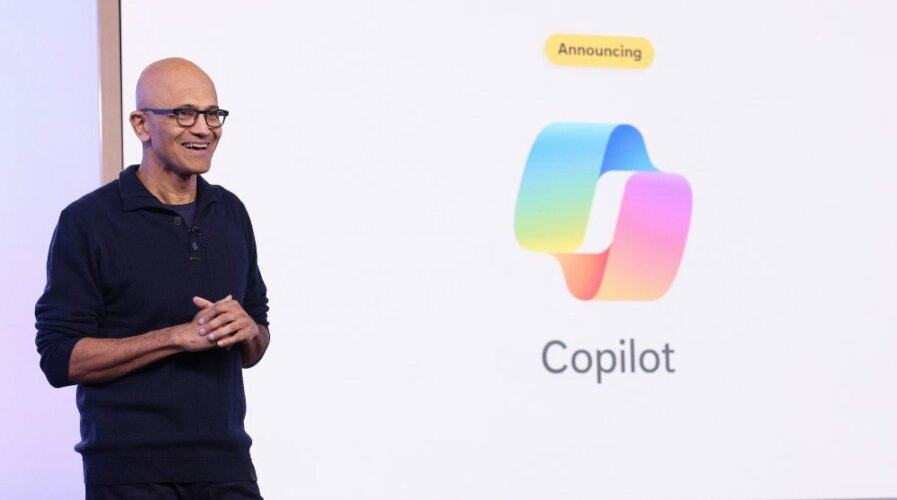
AI: Microsoft leans into AI Copilot. RTZ #470
I’ve been discussing Microsoft’s ‘All-in’ AI strategy around its Copilot brand for some months now, in this AI Tech Wave race. Microsoft CEO Satya Nadella has been ‘pedal to the metal’ on unleashing AI powered Copilot Github for Developers, Copilot for Windows and Office 365, Copilot for Microsoft’s enterprise software bundles, and of course, AI Copilot powered PCs a few months ago. And of course continue to leverage its iconic partnership with OpenAI.
It looks like the reception for Copilot, especially its premium priced subscription version, is seeing a slower than expected adoption rate. As The Information reports in “Microsoft Customers Pause on Office AI Assistant Due to Budgets, Bugs”:
“A Microsoft effort to inject AI into Excel, Word and PowerPoint has so far met a lukewarm response from customers due to performance and cost issues. Still, many remain optimistic about future improvements.”
“Microsoft’s vision of using artificial intelligence to take some of the drudgery out of creating spreadsheets, documents and slide presentations is running into snags at businesses like Ascendion, a technology consulting firm.”
Microsoft has so many possible ways planned to make Copilot a financial success. And Wall Street is counting the ways:
“Microsoft’s AI Revenue Streams”
The many ways Microsoft makes money on AI
–365 Copilot: Hundreds of millions of dollars annually (analyst estimate)
•Usage of Azure by OpenAI: Around $4B annually
•OpenAI Models on Azure: Over $1B annually
•GitHub Copilot: $300M to $400M (analyst estimate)
•Additional AI Models on Azure
•Consumer Microsoft Copilot ad revenue (In Bing, Edge, Windows)
•Consumer Microsoft Copilot Pro subscriptions (In Bing, Edge, Windows)
•Other enterprise Copilots in finance, sales, security and service
“Source: The Information reporting”
Wall Street is anticipating AI Copilot revenues going from the hundreds of millions to billions a year soon. But it’s early days still.
“Fortunately for Microsoft, the company has other ways of making money from AI. OpenAI’s models all run on Microsoft’s Azure cloud platform, which means Microsoft makes money whenever people use ChatGPT and other OpenAI products. It also resells OpenAI’s models directly to businesses, and another Copilot product—GitHub Copilot, which automates computer programming—has become one of the biggest success stories in Microsoft’s sales of AI software.”
“So far, Microsoft hasn’t used the tactic for 365 Copilot that it often relies on to increase sales of new software products: bundling it with its broader suite of applications. Spataro said Microsoft currently has no plans to do so, in part because it is still convincing companies of the value of the software rather than pitching it as a more typical technology upgrade.”
But it’s small steps for now down a long road:
“The firm has about 100 employees testing a Microsoft AI feature known as 365 Copilot that automates tasks in Microsoft 365, the suite of applications, formerly known as Office, that includes Word, Excel and PowerPoint. The AI does a good job of summarizing recordings of meetings and drafting emails based on short written prompts, said Viral Tripathi, Ascension’s chief information officer.”
“However, Tripathi said, 365 Copilot has fallen short in other areas, such as generating visuals and presentations in Excel and PowerPoint. The firm still plans to expand its use of the AI feature to all of its 3,500 employees globally, as long as it can demonstrate a return on its investment in the technology. “So far, we’ve had mixed results,” he said. “Most people don’t find it that valuable right now, but it’s a product that’s going to improve over time.”
“Corporate technology managers are echoing that perspective about Microsoft’s efforts to remake its productivity applications—one of the most lucrative and longstanding software franchises—for the AI era. While there’s still optimism that 365 Copilot and other forms of AI will eventually deliver breakthroughs in productivity and other benefits, many businesses say they haven’t seen them yet and aren’t sure when they will.”
“For Microsoft, it’s particularly important that those results materialize. The company has placed some of the most ambitious bets in the tech industry on AI, most notably by injecting $13 billion in cash and credits for cloud computing services into OpenAI, the startup that sparked the current, thunderous AI hype cycle with its ChatGPT chatbot.”
“Among other things, that relationship gave Microsoft the right to use OpenAI’s large language models, known as GPT, throughout its vast product line. GPT, along with other models Microsoft has developed in-house, powers 365 Copilot, which Microsoft made broadly available in January as an add-on feature that costs $30 a month per person before discounts.”
“So far, only a small portion of Microsoft’s business customers has adopted Copilot: Between 0.1% and 1% of the 440 million existing users of Microsoft 365 are also paying for the new AI features, equity analysts estimate. That translates to between 400,000 and 4 million paid seats for the Copilot product, which could mean the product is on track to generate hundreds of millions of dollars in revenue annually.”
“Other signs back up those estimates: Around March of this year, Microsoft had set aside enough server capacity in its data centers for 365 Copilot to handle daily users of the AI assistant in the low millions, according to someone with direct knowledge of those plans. It couldn’t be learned how much of that capacity was in use at the time”
This is important since AI software as I’ve pointed out before, has significant variable costs as customers really start to use the products and services.
Of course competitors are rushing to pounce on Microsoft’s Copilot headwinds:
“Some of Microsoft’s competitors have begun playing up the hiccups the company’s customers have experienced with its AI assistant for its apps, including Salesforce CEO Marc Benioff, whose company offers its own AI assistant.”
“So many customers are so disappointed about what they bought from Microsoft, Copilots, because they’re not getting the accuracy and the response that they want,” Benioff, a longtime Microsoft critic, said during the company’s quarterly earnings call last week. “Microsoft has disappointed so many customers with AI.”
“For its part, Microsoft says it’s releasing updates to 365 Copilot that will improve its performance. It declined to comment on sales of 365 Copilot or analyst estimates; for the June quarter, the company said it had 60% more customers using the product than in the prior quarter.”
“But it also says budget constraints are also holding back customer adoption of the software. The price tag for 365 Copilot roughly doubles the cost of a basic Office subscription.”
“My sense is that organizations’ ability to absorb the innovation is not nearly as great as the innovation that’s coming their way right now,” Jared Spataro, Microsoft corporate vice president, said. “And that’s a statement about how budgets work. They can’t even scrape together the right budgets to buy this stuff.”
However, CEO Satya Nadella is not pausing, and adjusting Copilot for better performance and value:
“Microsoft plans to announce updates to Excel and PowerPoint in the “coming weeks,” Spataro said. On Tuesday, it announced that Spataro and Microsoft CEO Satya Nadella will give a presentation on “the next wave of Copilot innovation” later this month.”
“Nadella has been closely monitoring work on the products. Every Friday, he pores over Microsoft’s sales of 365 Copilot, and he has told colleagues he expects the assistant will eventually become a lucrative product for the company, according to someone who spoke to him earlier this year.”
And the company is focused on cost efficiencies wherever possible:
“Meanwhile, Microsoft is also making changes that could make 365 Copilot more profitable. Earlier this year, Microsoft began swapping out GPT-4—the OpenAI LLM that had been powering the AI assistant—in favor of Microsoft’s smaller in-house models for some of the more rudimentary functions in 365 Copilot, such as creating text summaries, according to another person involved in the effort.”
“The Microsoft in-house models, called Phi, require less computing power to run and cut costs. More recently, Microsoft moved most of 365 Copilot’s features to OpenAI’s latest model, GPT-4o, which brought down costs even more, this person said.”
All this is to highlight my oft-repeated point in this AI Tech Wave, that AI product iteration, customer experimentation, and adoption at Scale will take longer than currently expected.
Much as it always does in prior tech waves. But when it all clicks, things move forward at a faster clip. Stay tuned.
(NOTE: The discussions here are for information purposes only, and not meant as investment advice at any time. Thanks for joining us here)










